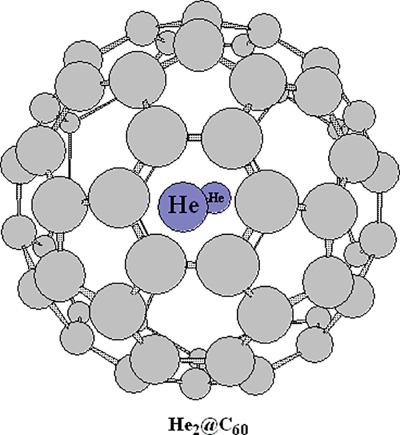当前位置:
X-MOL 学术
›
J. Comput. Chem.
›
论文详情
Our official English website, www.x-mol.net, welcomes your
feedback! (Note: you will need to create a separate account there.)
On the existence of HeHe bond in the endohedral fullerene Не2 @C60
Journal of Computational Chemistry ( IF 3.4 ) Pub Date : 2017-09-06 , DOI: 10.1002/jcc.25061 Tymofii Yu. Nikolaienko 1 , Eugene S. Kryachko 2 , Grygoriy A. Dolgonos 3
Journal of Computational Chemistry ( IF 3.4 ) Pub Date : 2017-09-06 , DOI: 10.1002/jcc.25061 Tymofii Yu. Nikolaienko 1 , Eugene S. Kryachko 2 , Grygoriy A. Dolgonos 3
Affiliation

|
Twenty years have already been passed since the endohedral fullerene's void ceaselessly attracts attention of both, experimentalists and theoreticians, computational chemists and physicists in particular, who direct their efforts on computer simulations of encapsulating atoms and molecules into fullerene void and on unraveling the arising bonding patterns. We review recent developments on the endohedral He2@C60 fullerene, on its experimental observation and on related computational works. The two latter are the main concerns in the present work: on the one hand, there experimentally exists the He dimer embedded into C60 void. On the other, computational side, each He atom exhibits a negligible charge transfer to C60 resulting in that altogether, the He dimer exists as a fractionally charged (He+δ)2. Whether there exists a bond between these two helium atoms is the key question of the present work. Since a bond is a two‐body creature, we assert that it suffices to define the bond on the basis of Löwdin's postulate of a molecule which we invoke to investigate such formation of the He dimer in a given C60 void in terms of the HeHe potential energy well. It is analytically demonstrated that this well enables to maintain at least one bound (ground) state, and therefore, according to Löwdin's postulate which is naturally anticipated within quantum theory, we infer that (He+δ)2 is a molecule, a diatomic, where two heliums are bonded to each other. Using these arguments, we also propose to extend the concept of stability of endohedral fullerenes. © 2017 Wiley Periodicals, Inc.
中文翻译:

关于内嵌富勒烯Не2@C60中HeHe键的存在
自从内嵌富勒烯的空洞不断吸引实验家和理论家,特别是计算化学家和物理学家的注意力以来,二十年已经过去了,他们致力于将原子和分子封装到富勒烯空洞中的计算机模拟以及解开产生的键合模式. 我们回顾了内嵌 He2@C60 富勒烯的最新进展、其实验观察和相关计算工作。后两者是目前工作中的主要关注点:一方面,实验上存在嵌入 C60 空隙中的 He 二聚体。另一方面,在计算方面,每个 He 原子都表现出可忽略不计的电荷转移到 C60,导致整体上,He 二聚体以带电荷的 (He+δ)2 形式存在。这两个氦原子之间是否存在键是当前工作的关键问题。由于键是双体生物,我们断言根据 Löwdin 的分子假设来定义键就足够了,我们调用该假设来研究在给定的 C60 空隙中 He 二聚体的这种形成,根据 He他势能很好。分析证明,这口井能够维持至少一个束缚(基)态,因此,根据量子理论中自然预期的 Löwdin 假设,我们推断 (He+δ)2 是一种分子,一种双原子,其中两个氦相互结合。使用这些论点,我们还建议扩展内嵌富勒烯稳定性的概念。© 2017 威利期刊公司。由于键是双体生物,我们断言根据 Löwdin 的分子假设来定义键就足够了,我们调用该假设来研究在给定的 C60 空隙中 He 二聚体的这种形成,根据 He他势能很好。分析证明,这口井能够维持至少一个束缚(基)态,因此,根据量子理论中自然预期的 Löwdin 假设,我们推断 (He+δ)2 是一种分子,一种双原子,其中两个氦相互结合。使用这些论点,我们还建议扩展内嵌富勒烯稳定性的概念。© 2017 威利期刊公司。由于键是双体生物,我们断言根据 Löwdin 的分子假设来定义键就足够了,我们调用该假设来研究在给定的 C60 空隙中 He 二聚体的这种形成,根据 He他势能很好。分析证明,这口井能够维持至少一个束缚(基)态,因此,根据量子理论中自然预期的 Löwdin 假设,我们推断 (He+δ)2 是一种分子,一种双原子,其中两个氦相互结合。使用这些论点,我们还建议扩展内嵌富勒烯稳定性的概念。© 2017 威利期刊公司。一个分子的假设,我们调用它来研究在给定的 C60 空隙中 He 二聚体的这种形成,就 HeHe 势能井而言。分析证明,这口井能够维持至少一个束缚(基)态,因此,根据量子理论中自然预期的 Löwdin 假设,我们推断 (He+δ)2 是一种分子,一种双原子,其中两个氦相互结合。使用这些论点,我们还建议扩展内嵌富勒烯稳定性的概念。© 2017 威利期刊公司。一个分子的假设,我们调用它来研究在给定的 C60 空隙中 He 二聚体的这种形成,就 HeHe 势能井而言。分析证明,这口井能够维持至少一个束缚(基)态,因此,根据量子理论中自然预期的 Löwdin 假设,我们推断 (He+δ)2 是一种分子,一种双原子,其中两个氦相互结合。使用这些论点,我们还建议扩展内嵌富勒烯稳定性的概念。© 2017 威利期刊公司。根据量子理论中自然预期的假设,我们推断 (He+δ)2 是一个分子,一个双原子分子,其中两个氦相互键合。使用这些论点,我们还建议扩展内嵌富勒烯稳定性的概念。© 2017 威利期刊公司。根据量子理论中自然预期的假设,我们推断 (He+δ)2 是一个分子,一个双原子分子,其中两个氦相互键合。使用这些论点,我们还建议扩展内嵌富勒烯稳定性的概念。© 2017 威利期刊公司。
更新日期:2017-09-06
中文翻译:

关于内嵌富勒烯Не2@C60中HeHe键的存在
自从内嵌富勒烯的空洞不断吸引实验家和理论家,特别是计算化学家和物理学家的注意力以来,二十年已经过去了,他们致力于将原子和分子封装到富勒烯空洞中的计算机模拟以及解开产生的键合模式. 我们回顾了内嵌 He2@C60 富勒烯的最新进展、其实验观察和相关计算工作。后两者是目前工作中的主要关注点:一方面,实验上存在嵌入 C60 空隙中的 He 二聚体。另一方面,在计算方面,每个 He 原子都表现出可忽略不计的电荷转移到 C60,导致整体上,He 二聚体以带电荷的 (He+δ)2 形式存在。这两个氦原子之间是否存在键是当前工作的关键问题。由于键是双体生物,我们断言根据 Löwdin 的分子假设来定义键就足够了,我们调用该假设来研究在给定的 C60 空隙中 He 二聚体的这种形成,根据 He他势能很好。分析证明,这口井能够维持至少一个束缚(基)态,因此,根据量子理论中自然预期的 Löwdin 假设,我们推断 (He+δ)2 是一种分子,一种双原子,其中两个氦相互结合。使用这些论点,我们还建议扩展内嵌富勒烯稳定性的概念。© 2017 威利期刊公司。由于键是双体生物,我们断言根据 Löwdin 的分子假设来定义键就足够了,我们调用该假设来研究在给定的 C60 空隙中 He 二聚体的这种形成,根据 He他势能很好。分析证明,这口井能够维持至少一个束缚(基)态,因此,根据量子理论中自然预期的 Löwdin 假设,我们推断 (He+δ)2 是一种分子,一种双原子,其中两个氦相互结合。使用这些论点,我们还建议扩展内嵌富勒烯稳定性的概念。© 2017 威利期刊公司。由于键是双体生物,我们断言根据 Löwdin 的分子假设来定义键就足够了,我们调用该假设来研究在给定的 C60 空隙中 He 二聚体的这种形成,根据 He他势能很好。分析证明,这口井能够维持至少一个束缚(基)态,因此,根据量子理论中自然预期的 Löwdin 假设,我们推断 (He+δ)2 是一种分子,一种双原子,其中两个氦相互结合。使用这些论点,我们还建议扩展内嵌富勒烯稳定性的概念。© 2017 威利期刊公司。一个分子的假设,我们调用它来研究在给定的 C60 空隙中 He 二聚体的这种形成,就 HeHe 势能井而言。分析证明,这口井能够维持至少一个束缚(基)态,因此,根据量子理论中自然预期的 Löwdin 假设,我们推断 (He+δ)2 是一种分子,一种双原子,其中两个氦相互结合。使用这些论点,我们还建议扩展内嵌富勒烯稳定性的概念。© 2017 威利期刊公司。一个分子的假设,我们调用它来研究在给定的 C60 空隙中 He 二聚体的这种形成,就 HeHe 势能井而言。分析证明,这口井能够维持至少一个束缚(基)态,因此,根据量子理论中自然预期的 Löwdin 假设,我们推断 (He+δ)2 是一种分子,一种双原子,其中两个氦相互结合。使用这些论点,我们还建议扩展内嵌富勒烯稳定性的概念。© 2017 威利期刊公司。根据量子理论中自然预期的假设,我们推断 (He+δ)2 是一个分子,一个双原子分子,其中两个氦相互键合。使用这些论点,我们还建议扩展内嵌富勒烯稳定性的概念。© 2017 威利期刊公司。根据量子理论中自然预期的假设,我们推断 (He+δ)2 是一个分子,一个双原子分子,其中两个氦相互键合。使用这些论点,我们还建议扩展内嵌富勒烯稳定性的概念。© 2017 威利期刊公司。











































 京公网安备 11010802027423号
京公网安备 11010802027423号